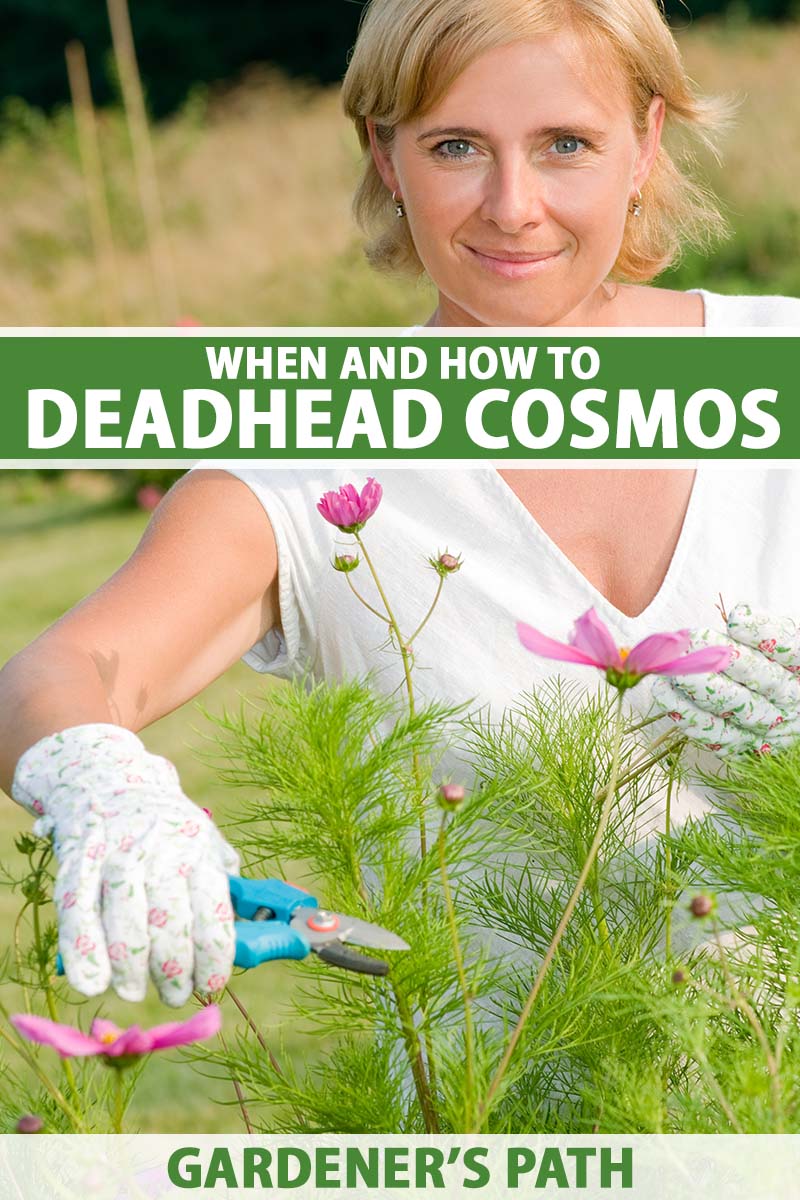Cosmos are gorgeous annual or perennial flowers that no garden should be without!
When you grow these wispy summertime plants in your ornamental beds or among your vegetable crops, you might wonder if you should remove the faded blooms or just leave them be?
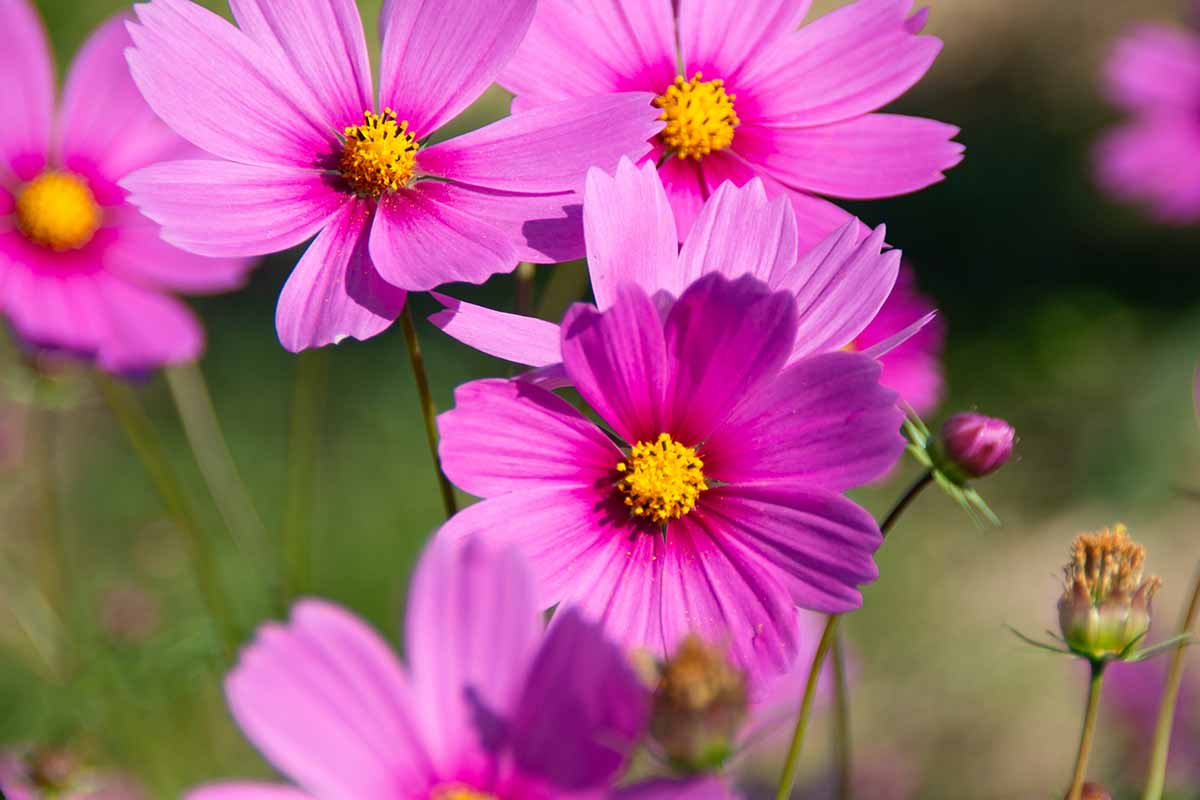
We link to vendors to help you find relevant products. If you buy from one of our links, we may earn a commission.
If you’ve decided you prefer a tidy floral display with only fresh looking blooms, you may have questions about pruning off the faded floral parts of your cosmos plants:
Where do you cut exactly? And how do you tell the difference between a seed head and a fresh, new flower bud?
In this article I’ll present the pros and cons of this decision so you can choose whether or not to bother with deadheading the cosmos flowers in your garden or yard – and how to proceed if the pros win you over!
Here’s what I’ll cover:
What You’ll Learn
Before we get started, if you want to review the basics of cultivating these summer annuals, be sure to read our complete guide to growing cosmos in the garden.
Should You Deadhead Cosmos Flowers?
Rather than looking for guidance about how to prune, are you wondering if you actually need to cut back the faded blooms of Cosmos species in your garden or yard?
Afterall, there are so many other important summer activities that could take the place of this one – relaxing in the gazebo, planning ornamental landscaping around your favorite garden bench, or catching up on reading your stack of gardening books!
Commonly known as deadheading, removing spent flowers is a technique used by gardeners to refresh plants, encouraging more blooms and bushier growth.
I’ll present you with the pros and cons of undertaking this chore with these particular plants so that you can make an informed decision.

There are several reason you may want to consider deadheading cosmos aka Mexican aster flowers:
If you want to encourage bushier growth in these flowering plants, deadheading as well as pruning can help.
Do you want your plants to focus all their energy on producing more flowers rather than making seeds? Then deadheading is the best choice for you.

Are the Cosmos species you’re growing perennials rather than annuals?
Annual species like C. bipinnatus and C. sulphureus tend to produce loads of flowers even without deadheading.
Perennials such as chocolate cosmos (C. atrosanguineus) don’t tend to have quite the long-lasting and overeager bloom load as the annuals.
So to keep C. atrosanguineus blooming, deadhead the spent flowers to encourage a longer blooming season.
Another practical reason that you may want to deadhead your cosmos is to prevent volunteers popping up in your garden.

C. bipinnatus self-seeds readily – so much so in fact, that it has become invasive in some areas. If you don’t want to see unplanned seedlings growing in your garden next season, removing seed heads before they mature is a good plan!
Of course, there’s also the possibility you absolutely cannot bear the sight of messy, faded flowers, in which case you’ll want to do some trimming.
Finally, if you are worried that your homeowners association will slap you with a steep fine for growing imperfect plants in an otherwise perfect neighborhood, well, yes, you better grab those pruners and start removing spent blooms.

Now that we’ve covered reasons in support of deadheading cosmos flowers, here are a few arguments in favor of allowing the faded blooms to complete their life cycle in your yard or garden:
Often the motivation for deadheading is to encourage “more blooms.” How many do you need exactly?
As a convert to the “let them be” camp, I have never once looked out at my garden and thought, “wow, my favorite ornamental annuals just aren’t blooming enough!”
If you feel like you’re not seeing enough blooms on the Mexican aster plants you’re growing, maybe you should sow more seeds!
These plants can also be grown in pots if you’re running out of room in your garden beds.
You can learn more about growing cosmos in containers in our guide.
To some of us – myself included! – the spent blooms are actually quite attractive. The dried up petals only remain in place for a few days before falling off and leaving behind a ripening seed head.
And that ripening seed head can be quite difficult to distinguish from a new flower bud to the untrained eye.
Personally, I love looking out over the large swaths of these blooms in my garden and seeing them at all different stages of their life cycle, from bud, to bright bloom, to maturing seed head, and I find this mix quite captivating.
For that matter, what is your garden aesthetic? If you enjoy a wild looking, cottage garden style for your ornamentals, there’s certainly no reason to deadhead cosmos.
And as a more practical motivation, if you skip deadheading, the seed heads will continue to ripen, eventually producing fully mature seeds that you can save to grow in future seasons or share with friends and family.
On the other hand, if you prune the seed heads before they mature, the seeds won’t be viable. They need to ripen on the plant.
Want to learn more about harvesting and saving cosmos seeds? Check out our article!
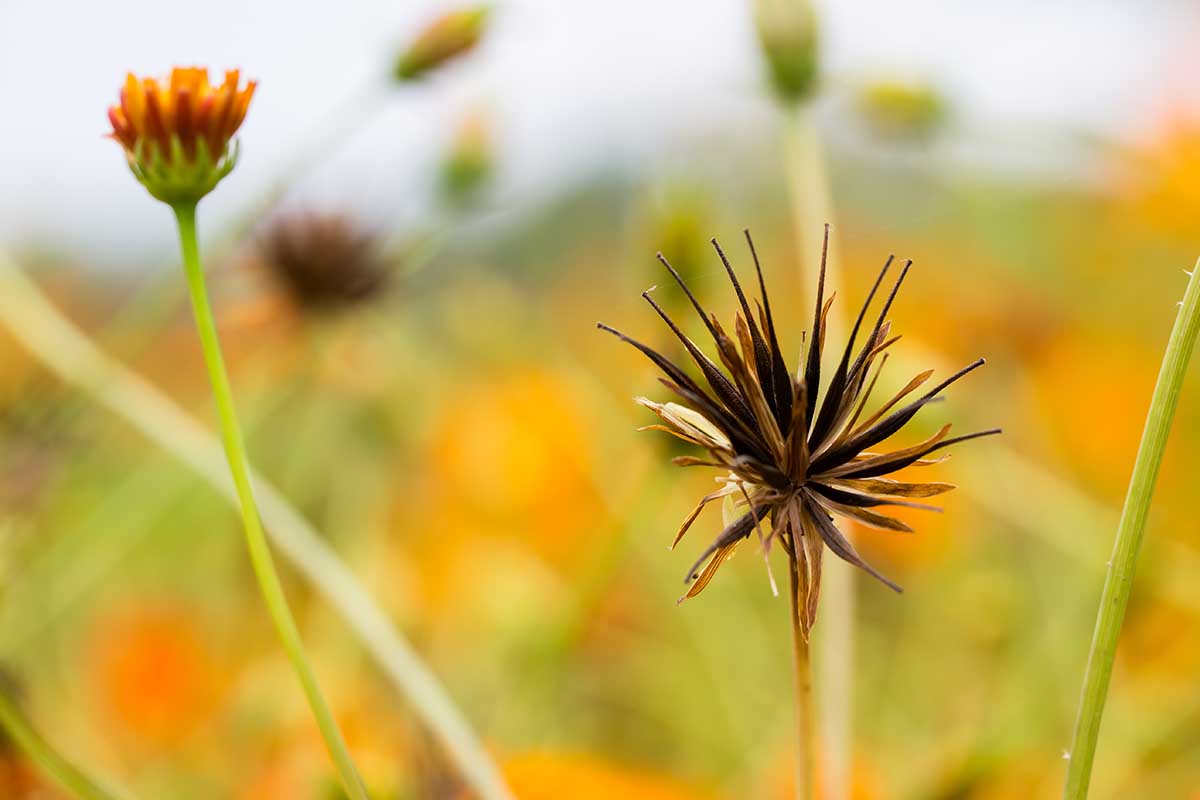
Another argument in favor of letting faded cosmos flowers remain rather than pruning them off is that the mature seeds actually provide good food for wild birds.
So if you’re interested in gardening for wildlife, you can easily leave this homegrown “bird food” for visiting wild birds to add to their menu.
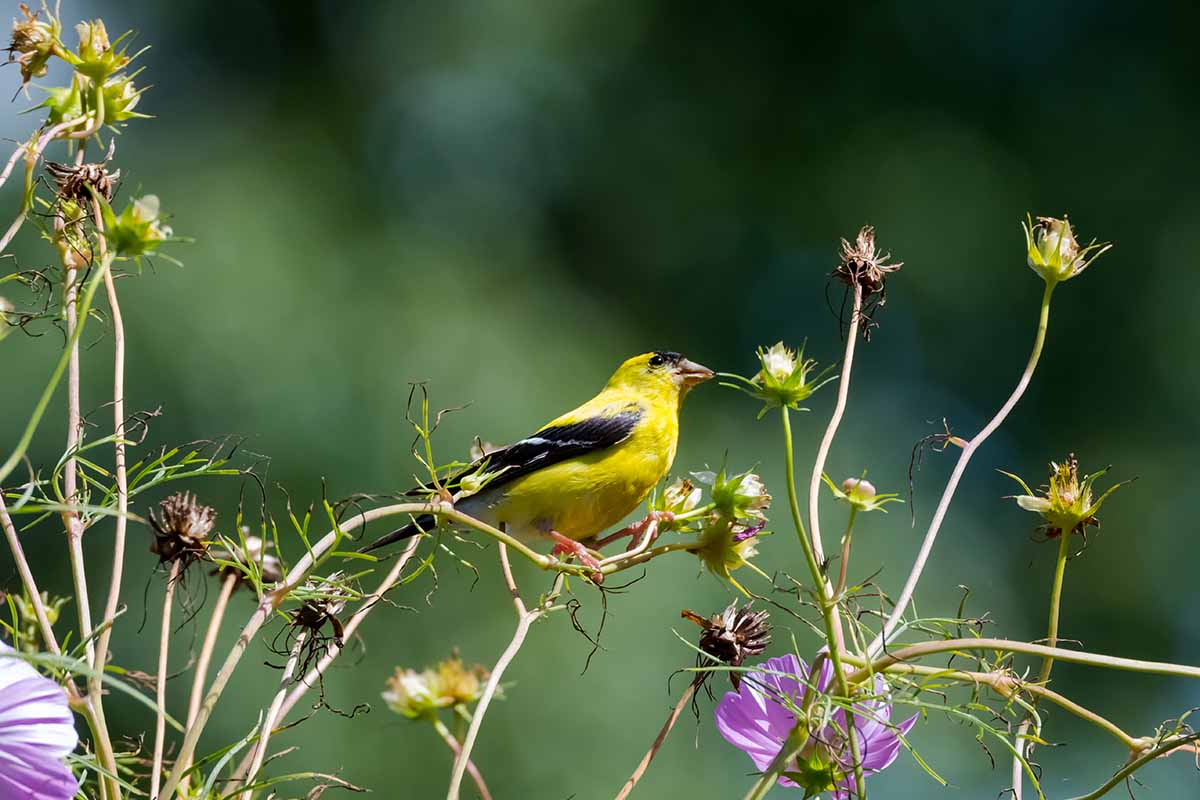
Finally, if you have a large number of these plants growing in your garden or yard, deadheading cosmos can be a time-consuming chore – unless you whack the plants back to a certain height, removing seed heads, new buds, and every floral stage in between.
In my very large polyculture garden where borage is rubbing elbows with cucumbers, and nasturtiums grow as a ground cover below my pole beans, I have more pressing work than deadheading cosmos flowers. There’s lettuce to be harvested and squash bugs to control!
I bet you may have other, more compelling gardening tasks to dig into as well.
Perhaps you’d like to spend some time learning how to create a gorgeous color scheme in your garden, extend your garden vertically, or xeriscape your yard to save water?
But if you were swayed by the pros of deadheading, I harbor no hard feelings. Read on to learn how to proceed!
How to Recognize Spent Flowers
Before you start snipping, you’ll want to be sure you know how to recognize spent flowers once the petals fall.
When the petals are still attached, it’s quite obvious that you’re dealing with a spent flower.

However, once the petals fall, there are some similarities between a yet to open flower bud and an unripe seed head – and the two can be difficult to tell apart if you don’t know what you’re looking for.
You certainly won’t want to trim off any flower buds if you can help it!

An unopened bud on the far right and an unripe seed head in the bottom center of the photo.
Unopened buds are rounded on the top, while unripe seed heads typically have a tufted appearance.
As seed heads start to mature, the seeds will turn brown and the seed heads will take on a spiky shape.
In contrast, the unopened buds have a smooth, rounded shape as you can see in this picture below.

Once you know what you’re looking for, it’s not so hard to tell the difference between buds and seed heads!
Where to Cut Faded Cosmos Flowers
Before you make your cuts I do recommend sterilizing your garden pruners by rubbing them down with hydrogen peroxide.
This will help you to avoid spreading disease throughout the garden.

Each flower has a stalk attached to a larger stem of the plant and you’ll need to make your cut at the base of the flower stalk, close to this larger stem.
Make your cut next to the stem, so that you don’t leave a beheaded flower stalk behind, which would frankly be much more unattractive than the spent blooms you are removing!
And that’s it!
This method will work for gardens and yards with small numbers of plants but will be very time consuming in larger spaces. If you have large numbers of spent blooms to trim back, you may need to use a faster method.

For larger sized plantings, wait until most of the blooms on the plants have faded, then use garden shears or pruners to trim the plants back. You can cut them back to 12- to 18-inches tall if you’d like.
Of course, you’ll be sacrificing fresh blooms if you use this method, but the plants will become bushier and soon return to creating their floral show.
Would you like to dig even more deeply into the fine art of pruning off faded blooms?
Read our article to learn more about deadheading blooming plants in the garden.
To Snip or Not to Snip?
And voila! You now know how to deadhead cosmos flowers. And you also have plenty of reasons to support your decision to make the snip – or not!
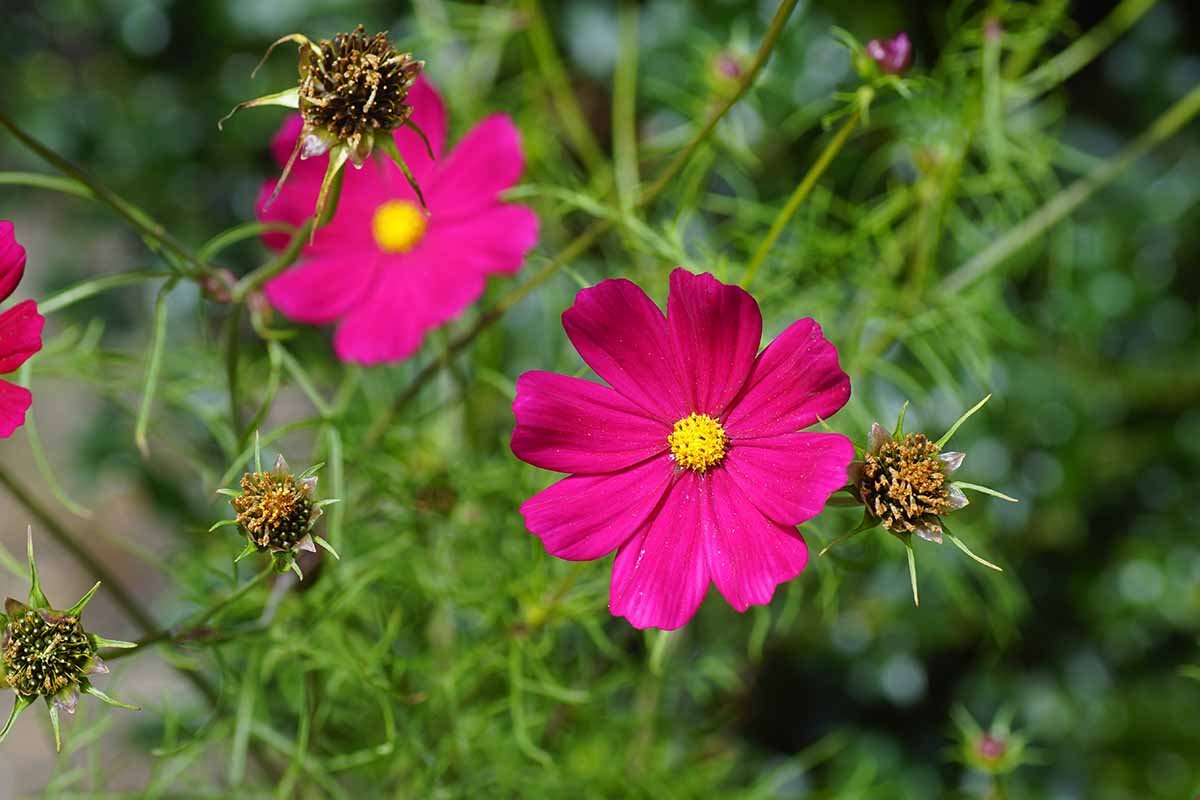
Let us know – after reading this article, did you choose to deadhead or to leave those faded blooms be? Tell us in the comment section below! And if you have any remaining questions, you can ask them there as well.
And while you’re learning about growing cosmos, here are a few other articles you may want to read as well:
